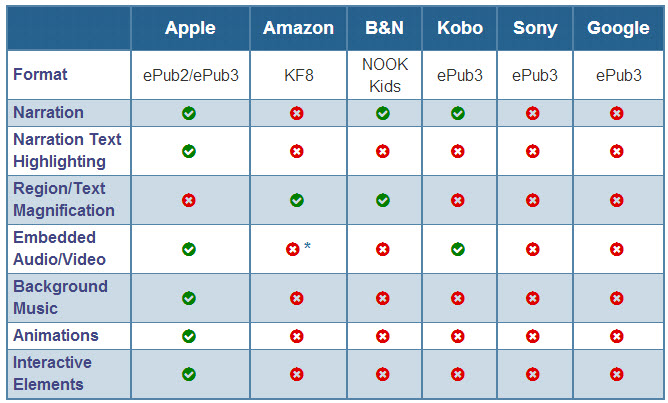May 27th, 2015
The book publishing industry adheres to more than a dozen standards. Among them are:
Barcoding Best Practices for the US Book Industry (incl. Bookland EAN)
BISAC (U.S.) & BIC (U.K.)
EDI
EDUPUB
ISBN
ONIX
PDF
THEMA
XBITS (papiNet)
There are also unofficial specifications, such as book trim sizes (different for the U.S. and the U.K.), that are so well entrenched in the practice of publishing that they might as well be standards.
And then there are ebook “standards”. The principal ones are:
EPUB 2.1
EPUB 3
Mobi (aka Mobipocket, and also its AZW variant)
KF8
We could easily add to that fixed format EPUBs and PDF (still extremely popular for online reading). Keep in mind that PDF has variants as well, such as PDF/X and PDF/A (and PDF/A, PDF/A-1a, PDF/A-1b, PDF/A-2 and PDF/A-2).
In my book, Mobile  Strategies for Digital Publishing, I ran this chart, sourced from eBook Architects. It doesn’t consider all of the pain points of creating files in various digital formats. Instead it reveals something perhaps more painful: even when you painstakingly create digital files according to their published specs, different ereaders fail to support many of the essential file features. (This chart is more than a year old, and so the specifics have changed. But not the overall problem).
Strategies for Digital Publishing, I ran this chart, sourced from eBook Architects. It doesn’t consider all of the pain points of creating files in various digital formats. Instead it reveals something perhaps more painful: even when you painstakingly create digital files according to their published specs, different ereaders fail to support many of the essential file features. (This chart is more than a year old, and so the specifics have changed. But not the overall problem).
As the IDPF (International Digital Publishing Forum) gathers today in New York City for its annual Digital Book Program we can only hope that the smart people in attendance will be working hard to reduce some of these roadblocks.